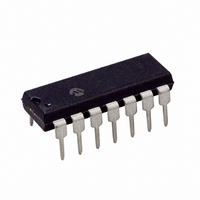PIC16F526-I/P Microchip Technology, PIC16F526-I/P Datasheet - Page 46

PIC16F526-I/P
Manufacturer Part Number
PIC16F526-I/P
Description
IC PIC MCU FLASH 1KX12 14DIP
Manufacturer
Microchip Technology
Series
PIC® 16Fr
Datasheets
1.PIC16F526-ISL.pdf
(122 pages)
2.PIC16F526-ISL.pdf
(22 pages)
3.PIC16F526-IP.pdf
(104 pages)
Specifications of PIC16F526-I/P
Program Memory Type
FLASH
Program Memory Size
1.5KB (1K x 12)
Package / Case
14-DIP (0.300", 7.62mm)
Core Processor
PIC
Core Size
8-Bit
Speed
20MHz
Peripherals
POR, WDT
Number Of I /o
11
Ram Size
67 x 8
Voltage - Supply (vcc/vdd)
2 V ~ 5.5 V
Data Converters
A/D 3x8b
Oscillator Type
Internal
Operating Temperature
-40°C ~ 85°C
Processor Series
PIC16F
Core
PIC
Data Bus Width
8 bit
Data Ram Size
67 B
Maximum Clock Frequency
20 MHz
Number Of Programmable I/os
12
Number Of Timers
1
Maximum Operating Temperature
+ 85 C
Mounting Style
Through Hole
3rd Party Development Tools
52715-96, 52716-328, 52717-734
Development Tools By Supplier
PG164130, DV164035, DV244005, DV164005, PG164120, ICE2000
Minimum Operating Temperature
- 40 C
On-chip Adc
8 bit, 3 Channel
Lead Free Status / RoHS Status
Lead free / RoHS Compliant
For Use With
AC162096 - HEADER MPLAB ICD2 PIC16F526 8/14
Eeprom Size
-
Connectivity
-
Lead Free Status / Rohs Status
Lead free / RoHS Compliant
PIC16F526
TABLE 8-2:
8.2.3
Either a prepackaged oscillator or a simple oscillator
circuit with TTL gates can be used as an external
crystal oscillator circuit. Prepackaged oscillators
provide a wide operating range and better stability. A
well-designed crystal oscillator will provide good
performance with TTL gates. Two types of crystal
oscillator circuits can be used: one with parallel
resonance, or one with series resonance.
Figure 8-3 shows implementation of a parallel resonant
oscillator circuit. The circuit is designed to use the
fundamental frequency of the crystal. The 74AS04
inverter performs the 180-degree phase shift that a
parallel oscillator requires. The 4.7 k resistor provides
the negative feedback for stability. The 10 k
potentiometers bias the 74AS04 in the linear region.
This circuit could be used for external oscillator
designs.
FIGURE 8-3:
DS41326E-page 46
Note 1:
Type
Osc
HS
LP
XT
2:
10k
Resonator
+5V
For V
recommended.
These values are for design guidance
only. Rs may be required to avoid over-
driving crystals with low drive level specifi-
cation. Since each crystal has its own
characteristics, the user should consult
the crystal manufacturer for appropriate
values of external components.
EXTERNAL CRYSTAL OSCILLATOR
CIRCUIT
32 kHz
200 kHz
20 MHz
20 pF
1 MHz
4 MHz
10k
Freq.
74AS04
DD
XTAL
4.7k
CAPACITOR SELECTION FOR
CRYSTAL OSCILLATOR
(1)
> 4.5V, C1 = C2 30 pF is
20 pF
EXTERNAL PARALLEL
RESONANT CRYSTAL
OSCILLATOR CIRCUIT
Cap. Range
15-47 pF
47-68 pF
10k
15 pF
15 pF
15 pF
74AS04
C1
To Other
Devices
Cap. Range
47-68 pF
15-47 pF
PIC16F526
CLKIN
15 pF
15 pF
15 pF
C2
(2)
Figure 8-4 shows a series resonant oscillator circuit.
This circuit is also designed to use the fundamental
frequency of the crystal. The inverter performs a 180-
degree phase shift in a series resonant oscillator
circuit. The 330 resistors provide the negative
feedback to bias the inverters in their linear region.
FIGURE 8-4:
8.2.4
For timing insensitive applications, the RC device
option offers additional cost savings. The RC oscillator
frequency is a function of the supply voltage, the resis-
tor (R
ing temperature. In addition to this, the oscillator
frequency will vary from unit-to-unit due to normal pro-
cess parameter variation. Furthermore, the difference
in lead frame capacitance between package types will
also affect the oscillation frequency, especially for low
C
variation due to tolerance of external R and C
components used.
Figure 8-5 shows how the R/C combination is con-
nected to the PIC16F526 device. For R
below 3.0 k, the oscillator operation may become
unstable, or stop completely. For very high R
(e.g., 1 M), the oscillator becomes sensitive to noise,
humidity and leakage. Thus, we recommend keeping
R
Although the oscillator will operate with no external
capacitor (C
above 20 pF for noise and stability reasons. With no or
small external capacitance, the oscillation frequency
can vary dramatically due to changes in external
capacitances, such as PCB trace capacitance or
package lead frame capacitance.
Section 14.0 “Electrical Characteristics” shows RC
frequency variation from part-to-part due to normal
process variation. The variation is larger for larger val-
ues of R (since leakage current variation will affect RC
frequency more for large R) and for smaller values of C
(since variation of input capacitance will affect RC
frequency more).
EXT
EXT
74AS04
330
EXT
values. The user also needs to take into account
between 5.0 k and 100 k.
) and capacitor (C
EXTERNAL RC OSCILLATOR
EXT
0.1 mF
XTAL
= 0 pF), we recommend using values
74AS04
330
EXTERNAL SERIES
RESONANT CRYSTAL
OSCILLATOR CIRCUIT
2010 Microchip Technology Inc.
EXT
) values, and the operat-
74AS04
To Other
Devices
EXT
EXT
PIC16F526
CLKIN
values
values














